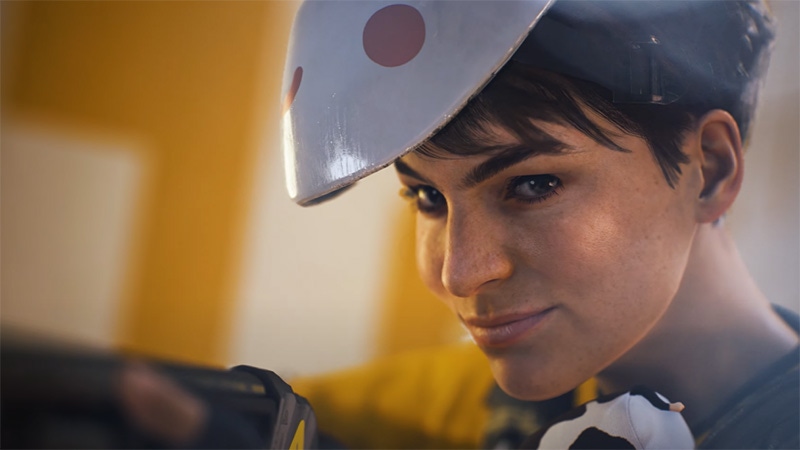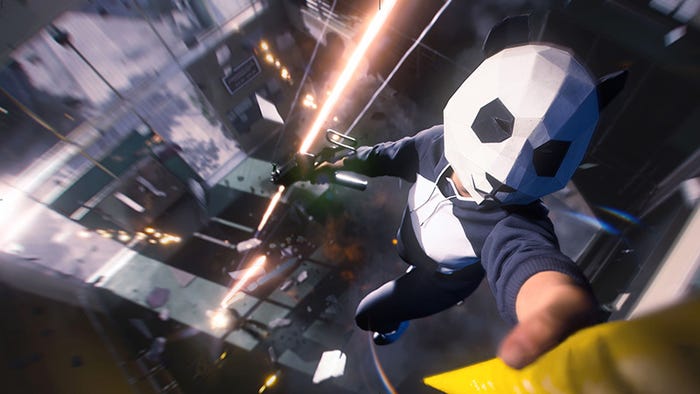Embark Studios: AI let devs "do more with less" when making The Finals
The creative team behind The Finals talks reshaping the dynamics of multiplayer map design, and why generative AI entered their production process.

Embark Studios' The Finals is a free-to-play online shooter that brings the Battlefield series' level of mayhem and destruction to an over-the-top team-based reality TV-style competition. After several months of playtests, The Finals is out, and the impressive technology behind its environmental chaos is now on display.
But as The Finals marched toward release, critics zeroed in on how Embark Studios (which is owned by Nexon) used generative AI technology to create in-game dialogue. As described by audio engineer Andreas Almström, text-to-voice AI allowed the studio to generate dynamic reactions by in-game characters, including in-universe commentators responding to the match.
Ahead of the surprise launch of The Finals at The Game Awards 2023, we spoke with Embark Studios creative director Gustav Tilleby, senior environment artist Joakim Stigsson, and brand director Sven Grundberg about using new tools to enhance the over-the-top action—including AI—and how The Finals disrupts the typically sacred rules of engagement for multiplayer games.
Blowing open a hole in multiplayer map design
Blending the gameplay of an extraction shooter and team-based multiplayer with the "levolution"-style map destruction from the Battlefield series, The Finals channels those fixtures of competitive gaming into a high-energy game show that feels made for the Twitch.tv generation.
As teams of show-boating ruffians battle it out over cash and bragging rights, the battleground combatants enter won't be the same one they close the game on as bullets, explosions, and other methods of brute force reshape the combat zone in real-time.According to creative director Gustav Tilleby, The Finals is about offering a more dynamic pace for a multiplayer game that puts its stylized, over-the-top competition into focus. "We have a lot of inspirations and touchstones for this game, such as The Running Man, The Hunger Games, and, of course, Squid Game. But one of our big inspirations was the classic arcade game Smash TV, which has a certain playfulness to it that we took to," said the creative director Tilleby. "When you eliminate someone, they explode into coins and all that stuff."

Image via Embark Studios.
“For The Finals, the style and tone of the game is built around pillars called appeal and brutality. It's about being inviting [and] playful. The Finals is set in a game show, but it has this explosive action that brings a lot of physicality and energy to the game."Along with scaling buildings and leaping off jump pads, the combatants can punch holes through walls, drop cash boxes by blowing out the floor beneath them, and cut off enemy shortcuts by blocking or destroying paths. This aspect gives The Finals somewhat of an immersive sim element to its flow, and Embark Studios' creative director even cited The Legend of Zelda: Breath of the Wild as an influence on the game.
Embracing Strategic Chaos
Implementing destructive environments in an online game disrupts one of the most useful tools for multiplayer developers—the design of the map—and creates new kinds of networking challenges to render the destruction equally for all players. One trick the developers use to convey the chaos in real-time for all players is keeping all data from the match on the server side, which prevents rubber-banding for players and lowers latency to ensure that everyone sees everything in real-time.
According to senior environment artist Joakim Stigsson, The Finals centers around creating a different type of flow for a multiplayer game, which pivots around how teams quite actually tear apart levels as the matches escalate. "We wanted to make a game that was almost fully destructible. You normally shouldn't be able to tear down as much as possible, but that encourages you to adapt to what's happening around you," said Stigsson. "You can shape and reform the environment, which influences the match's flow.”
“We also built design goals to encourage destruction in those spaces as much as possible. It makes the flow and pace feel dynamic…it's quite different designing maps in this way compared to more static levels where you don't necessarily need to think about certain things," he continued. "You can also hide a lot as well, you don't have to explain everything, like 'what's behind this wall?’ We really wanted to focus on ensuring that destroying buildings is not super easy, but still possible for anyone.”
Embark Studios values the use of generative AI tools
Despite the ambitious destruction and the long-term plans for support for The Finals, Embark Studios is still a modestly sized team that has leaned on new tools and assets to assist with the heavy lifting—including generative AI programs.
Given the rapid and mostly unchecked growth of AI (often touted by executives as a tool to reduce costs and replace employees), this became a concern for voice actors and other developers on social media.
Embark Studios' brand director, Sven Grundberg, took a moment during our interview to address the backlash and explain their reasoning for using AI tools."We saw the discussion happening, and one of the reasons we discussed it from the onset [on the developer podcast] was because we have been super transparent about the use of AI-based TTS (text-to-speech) in the game," said Grundberg. "One thing that we want to make really clear in terms of how we use those tools in The Finals is that we use a combination of recorded voice actors and AI based TTS that is based on contracted voice actors, we don't generate voice and video from thin air."

Image via Embark Studios.
He characterized the use of generative AI tools as a process that allowed a small team of veteran developers to create the kinds of games they used to make at larger studios. “We can sort of work better and faster, and do more with less,” Grundberg explained. “That's been throughout all levels of craft at Embark Studios, which includes procedural tools for environmental design, like photogrammetry, and other areas like animation as well.”
“I think with these new tools, they're not going to go away. The important thing for us is to be transparent about the way we use them. That's the context we want to provide, going forward."Grunberg further stated that the current wave of AI tools has brought about a change in tech and game development, which will see developers adapting to new changes and programs. He compared the onset of generative AI tools to the game industry’s shift from 2D to 3D games.
Nevertheless, he stated again that it isn’t Embark Studios’ intent to replace voice actors. “We use a bunch of voice actors for our game, they come in to record, and we're always happy with their work – but these new tools allow us to do things that we couldn't do before outside of our means."So far, The Finals is looking to have a promising start for its life as a new multiplayer shooter—it attracted millions of players in its pre-release beta and, since launch, regularly sees over 200,000 players logged in during peak hours.
With its fast-paced matches and a deep focus on tearing battlegrounds apart to level the playing field, Embark Studios’ vision for a chaotic online shooter made by a modestly-sized team might leave a mark in a market segment that’s been through a brutal year.
About the Author
You May Also Like









